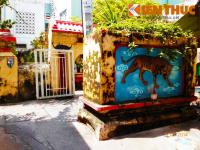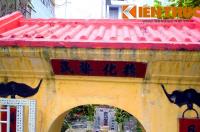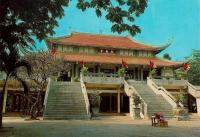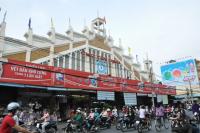Phan Tấn Huỳnh Tomb 
1754-1824, Deputy of Marshal Le Van Duyet
Overview
Hidden away at the end of an alley in Phú Nhuận is the forgotten tomb of Marshal Lê Văn Duyệt’s deputy, Phan Tấn Huỳnh.
Phan Tấn Huỳnh (1754-1824) was a royal mandarin who distinguished himself in the 1790s in the military service of Lord Nguyễn Phúc Ánh, later becoming a high-ranking official at Gia Định Citadel. His modest tomb, situated at the end of Hẻm 120 Huỳnh Văn Bánh in Phú Nhuận district, is housed within a small walled compound and concealed by a large screen.

The Phan Tấn Huỳnh tomb at Hẻm 120 Huỳnh Văn Bánh in Phú Nhuận district.
The screen in front of Phan Tấn Huỳnh’s tomb features paintings of a tiger on the front and a coastal scene on the rear. The tomb itself is accessed by a small gate with an imitation traditional tube-tiled roof, above which are inscribed the Chinese characters 德化黎民 (Dé huà lí mín or Đức hóa lê dân, literally “Making the common people virtuous”). Twin sentences (câu đối) in Chinese on either side of the gate praise Phan Tấn Huỳnh’s great loyalty and service to his country.

The tiger on the front face of the screen at the Phan Tấn Huỳnh tomb.

The Chinese characters 德化黎民 (Dé huà lí mín or Đức hóa lê dân, literally “Making the common people virtuous”) above the gate of the Phan Tấn Huỳnh tomb.
Inside the tomb compound, there is an altar in front of the tomb, backed by a small stele bearing Phan Tấn Huỳnh’s names and titles. However, it is the eulogy – inscribed in Chinese characters on the rear screen behind the tomb – which tells us most about the man who was buried here nearly 200 years ago.
According to the eulogy, Phan Tấn Huỳnh (posthumous name Khiêm) was a descendant of one Phan Công Thiên, who migrated from Quảng Nam to Gia Ðịnh in the late 17th century. During the Nguyễn-Tây Sơn war, “having greater skill than others,” Huỳnh fought courageously in Nguyễn Phúc Ánh's armies under such famous generals as Lê Văn Duyệt, Ngô Tùng Châu, Võ Tánh and Trương Tấn Bửu.
In front of the tomb is an altar and a small stele bearing Phan Tấn Huỳnh’s names and titles.
In 1802, after Nguyễn Phúc Ánh took the throne as King Gia Long, Phan Tấn Huỳnh was granted the honorary title Hoàng Ngọc Hầu. Then in 1807, he himself became a General and High-ranking Special Envoy, charged with assisting Marshal Lê Văn Duyệt in his duties as Governor of Gia Định.
Phan Tấn Huỳnh distinguished himself in battle again in 1809-1816, when he served as deputy commander of a long campaign against rebel forces in Quảng Ngãi.
In 1820, he became Divisional Commander of Phiên An (Bến Nghé, now Saigon), and “over the next two years, all of the documents of Marshal Lê Văn Duyệt were drafted by his hand.” During this period, he also promoted the colonisation of new land in Gia Định by offering incentives to Việt settlers.

Behind the tomb is a large screen inscribed with Chinese characters which recount Phan Tiến Huỳnh’s distinguished career.
In 1822, Phan Tấn Huỳnh’s health began to deteriorate due to old age and he was permitted to retire on an official pension. However, the eulogy tells us that just two years later, “for reasons of poor health and severe illness, he did not want to become an encumbrance to his children, so he committed suicide to free himself from suffering, on the 11th day of the 11th lunar month in the fifth year of King Minh Mạng (1824).”
Not yet recognised as a heritage site, the Phan Tấn Huỳnh Tomb is currently cared for by a local family, though sadly, few of the other residents of Hẻm 120 seem to have any knowledge about the great royal mandarin buried in their midst.
Tim Doling is the author of the walking tour book Exploring Hồ Chí Minh City (Nhà Xuất Bản Thế Giới, Hà Nội, 2014) and also conducts Heritage Tours of Saigon and Chợ Lớn - see www.historicvietnam.com.
Location

|

© Đây là ngôi mộ danh tướng Phan Tấn Huỳnh từng theo phò vua Gia Long cùng với Lê Văn Duyệt, Trương Tấn Bửu, Võ Tánh giành... |

© Đây là ngôi mộ danh tướng Phan Tấn Huỳnh từng theo phò vua Gia Long cùng với Lê Văn Duyệt, Trương Tấn Bửu, Võ Tánh giành... |

© Khu lăng mộ nằm giữa khu dân cư có nền đất cao so với khu vực xung quanh nhưng do những lần nâng cấp đường xá nên ngôi... |

© Hình ảnh mái ngói của lăng mộ Phan Tấn Huỳnh có dạng hai mái, giả ngói lợp. |

© Ngôi mộ có bình đồ hình chữ nhật, với hệ thống tường thành bao quanh dài 12,25m; rộng ngang 6,5m, có 4 trụ ở 4 góc. |

© Đi qua cổng sẽ bắt gặp bàn hương án được xây thành khối đắp nổi các họa tiết trang trí tạo thành hình chiếc sập... |

© Tiếp đến là một Bia mộ đúc bằng hợp chất, trên bia khắc chìm chữ Hán với nội dung: Hoàng Việt; Huỳnh Quang Hầu, nguyên... |

© Nấm mộ có dạng liếp hình chữ nhật giật hai cấp. Phan Tấn Huỳnh được phong tước Hầu vì có công trong việc khai hoang... |

© Kết thúc kiến trúc là bình phong hậu với phần đế được làm bằng hợp chất đắp nổi như một chân sập gụ, cầu kỳ... |

© Phần bia đá bình phong hậu cho ta biết thêm về các chức vụ ông từng kinh qua và đặc biệt hơn ta còn biết được Phan Tấn... |

© Hai bên bia đá phía sau được trang trí họa tiết những cuốn án thư uốn lượn, chứng tỏ chủ nhân của ngôi mộ là người... |

© Phan Tấn Huỳnh từ quan vào năm 1820 và từ trần vào ngày 11/11/1822. Khi biết mình già yếu ông đã tự kết liễu đời mình... |

© Ngôi mộ vẫn được những người dân xung quanh nhang khói và góp tiền tu bổ mỗi khi xuống cấp. |

© Hiện nay, Trung tâm Bảo tồn Di tích và Danh thắng Thành phố Hồ Chí Minh đang tiến hành lập hồ sơ để xếp hạng khu lăng... |
Insight
Comments
Note: we are not responsible for the comments posted by users
|

|
| Address |
114 Huỳnh Văn Bánh, phường 12, Phú Nhuận, Hồ Chí Minh, Vietnam |
| Added by |
admin |
| Added on |
2015-05-12 09:17:34 |
| Members |
|

|
|

(390 m) |

(505 m) |

(617 m) |

(989 m) |

(1.17 km) |

(1.18 km) |

(1.62 km) |

(1.65 km) |
|